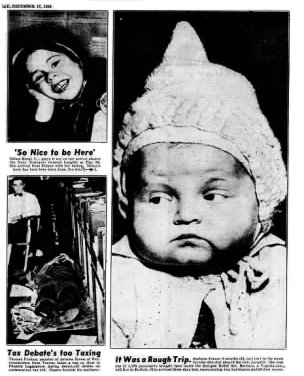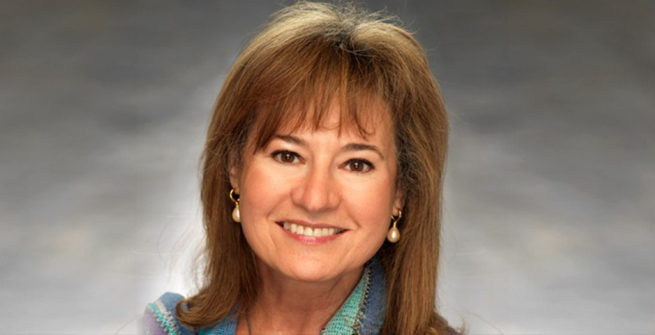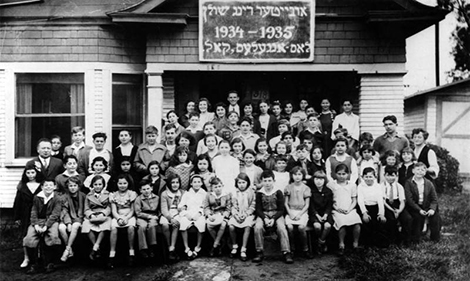Miri Koral is the Founding Director of the California Institute for Yiddish Culture and Language and a native speaker of Yiddish. She will be facilitating the book discussions for the Yiddish Book Center's "Coming to America" Reading Groups for Public Libraries, starting in February. She shared some information about her background with librarian Wendy Westgate for the LAPL Blog.
You don’t have to step off the boat to feel like you’ve finally come to America; you just have to catch your first sight of the Statue of Liberty, a tiny bright speck against the dark water and sky that slowly grows into a dazzle of beckoning green majesty. Behind her, jeweled lights, the luminous cloak of a welcoming city.
This magic was better than any a three-and-a-half-year-old could have dreamed up as she was hoisted up in her papa’s arms to see above the heads of fellow passengers, crowded in hushed awe on the deck of a U.S. Merchant Marine vessel out of Hamburg, Germany.
It is so easy, even 60+ years later, to conjure the reverence and promise of those pre-dawn hours, the culmination of a journey across the Atlantic to the portal to a wondrous and novel world.
But reaching a haven from violence, repression, and economic hardship also comes at a cost—often it means relinquishing one’s native language and with it, the ancestral threads it connects one to.

The only language I spoke at the time I got off the boat was Yiddish. For better or worse, Yiddish was the only language I continued to speak at home. On rare occasions, when a visitor demanded it, speaking English with my parents made us feel like strangers to one another. Yiddish was my parents’ ancestral tongue, the generations-old mameloshn, and, in truth, the only thing aside from their religion that could not be stripped from them by either Hitler or Stalin. Yet.
From my parents’ generation to now has seen a 95% drop worldwide in native Yiddish speakers, from over 10 million pre-WW II to around half a million today. The main reasons for this huge drop involve deadly violence and upheaval, much like my family’s personal Polish Jewish history. But Yiddish in just my lifetime has been under a further two-pronged attack: one stems from the natural desire for assimilation into mainstream life; the other from the push to make Hebrew (Modern Israeli) the secondary language for Jews worldwide, replacing all other Jewish languages, the most prevalent of which was Yiddish.
Strangely, even those children of post-War Jewish immigrants who were spoken to in Yiddish by their parents were seldom encouraged to speak it themselves. It turned out I was an anomaly in my Baby Boomer generation, even growing up in New York City.
For the vast majority of Jews of European origin today (which is most Jews in the world), the result is cultural amnesia, a total disconnect from even the awareness that Yiddish is so much more than a few juicy words that sound funny in English.
Which brings me to the essence of my work and the work of the organization I founded in 1999, the California Institute for Yiddish Culture and Language (CIYCL): preventing the destructive powers set in motion in the last century from ultimately terminating an entire Yiddish-speaking civilization. Yes, on the ground, European and Russian Jewish cultures were utterly destroyed. But it’s clear that the remnants of those civilizations, and their offshoots in other places such as America, will be truly lost only if we allow them to disintegrate from our tongues.
In the 70s, I was among the pioneers in the field of Environmental Planning, which was my profession for several decades, to notable success. I had grown up enveloped in Yiddish secular culture—Yiddish books all over the house; attending Yiddish theater since I was a little girl; (involuntarily) partaking in my parents’ Yiddish-speaking social and political milieu; even attending a summer camp where Yiddish played a significant role in kids’ activities. It never sank in that once my parents’ generation was gone, all of that would virtually disappear.
With both my parents gone by the early 90s, I discovered I was rapidly losing my native tongue.
When I fully awakened to the reality of a nearly vanished world, I had to scramble to educate myself, to fill in the gaps of years of neglect and only a modicum of formal Yiddish training. Explorations that started in the early 1990s as a kind of band-aid unwittingly led to more significant curiosity and growing esteem and passion for Yiddish. It gave me so much unexpected joy to rediscover the unique world-class literature, the beautiful songs, films and plays, and, of course, the pithy humor and wit. And also to connect locally and globally with the many extraordinary people associated with its transmission and learning, past and present, including, to my delight, the great showmen Theo Bikel and Mike Burstyn. It was all such fun. But I soon realized that I was in a unique position to lead others to this treasure and legacy. Safeguarding the environment is unquestionably crucial, and one must continue to do all that one can, but other qualified folks can do the heavy lifting. Who better than me to safeguard the endangered language that is my own?
So why does promoting Yiddish matter so much to me, to the people that help support CIYCL’s efforts, and to those who make similar efforts in many and often surprising parts of the globe? How did it go from being a pastime to a serious career as a professor, nonprofit director, translator, and published poet?
The finding joy aspect cannot be overstated, for this is what propelled me.
Every language gives unique expression to a world view and to the singular values of the culture to which it belongs. Yiddish is no exception. But with its enormous literary and other cultural output that has been overlooked and forgotten over the past half-century, discovering Yiddish is, as the founder of the Yiddish Book Center, Aaron Lansky, put it, “like discovering a lost continent.”
For the thousands of people I’ve taught Yiddish language and culture to over the past 20+ years, there is firstly the joy of discovering, as one young woman put it, “something beautiful that belongs to you but that you didn’t even know you’d lost.” I take joy in their joy.
Aside from the singular gratification of interacting with a book, song, or performance, through Yiddish one also pulls aside the curtain concealing the complex and fascinating history of European Jewry, leading perhaps to a profound understanding of what shaped our ancestors’ responses to the unrelenting forces of modernity.
As the map to this wondrous lost continent becomes more and more—but not quite—indecipherable, how does one ensure that future generations can not only arrive there but use its 1,000-year bedrock for their unique creative expression?
Yiddish cultural expression, which in Los Angeles began in the late 19th century, has already had an outsize influence on the local scene, whether through its cinema, comedians, or its politics and founding of its premier hospitals. Though not nearly as populous and therefore as widespread and influential as in New York City, which once boasted over 20 Yiddish theaters on Second Avenue, there have been L.A. Yiddish culture clubs, newspapers, literary journals, Yiddish schools and Yiddish theater, and a one-and-only Yiddish Children’s Theater. A direct Yiddish cultural presence continues to this day.
When CIYCL started 20 years ago, most people attending our events could get a Yiddish joke or a poem, could appreciate a Yiddish play without supertitles. Today, CIYCL conducts most of its activities in English. Though I am part of a Yiddish reading circle and have the opportunity to teach in Yiddish, to converse in Yiddish with colleagues around the world, at CIYCL, we’re most committed to educating about Yiddish culture to showcase its enormous breadth and depth. We hope this way to spark people’s interest, whose next steps might be to take or encourage their kids to take a Yiddish language course. The numbers of these courses amazingly keep increasing around the world and online.
What sparked my newfound interest in Yiddish, in particular, was encountering the literature of Itzik Manger, known as the great Yiddish bard. His writing is irreverent and tongue-in-cheek brilliant, using juicy colloquialisms and biblical references. Many of his works—poetry and prose—have fortunately been translated into English by the late Leonard Wolf.
The three Yiddish authors whose works we’re going to discuss at the Los Angeles Public Library branches are among the very finest that Yiddish literature has to offer. I’ve taught their works in my classes at UCLA, usually in the original.
Sholem Aleichem’s character, Motl Peysi, much less known to the American public than his beloved Tevye (Fiddler on the Roof), is as much of a wisecracking and charming rascal as Mark Twain’s Tom Sawyer. Motl the Cantor’s Son is the revered author’s take on the turn-of-the-century New York Jewish scene. It’s poignantly humorous, an oxymoron which is Sholem Aleichem’s signature style.
Enemies, A Love Story is one of the most impactful novels I’ve ever read. I.B. Singer was a genius at understanding the human psyche in all its convoluted yet ultimately forgivable machinations. His story about a Holocaust survivor and his three women in post-War New York City is utterly unique and gripping.
Kadya Molodovsky, author of the novel A Jewish Refugee in New York, was herself a pre-War immigrant in New York City from Poland. This engaging novel makes you root for the young heroine in her struggles to make it in the big city as her family is being murdered in Europe.
I’m thrilled that we get to explore these gateways into Yiddish culture together at the Los Angeles Public Library branches!
Listen to a clip of Miri talking (in Yiddish, with English subtitles) about the role the Yiddish Book Center played in the direction her life took. The full oral history interview is available on the website of the Yiddish Book Center.
















